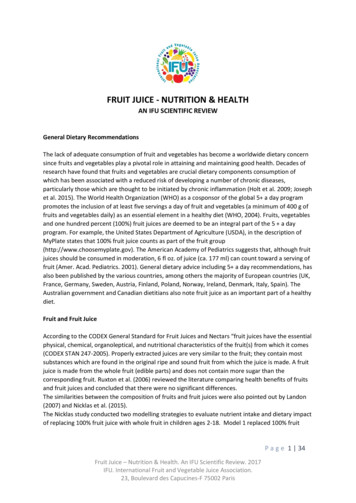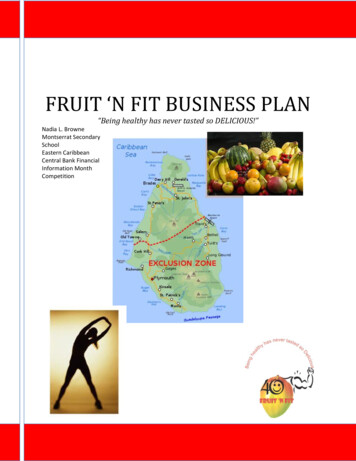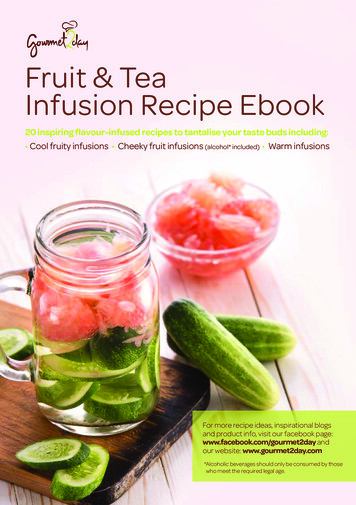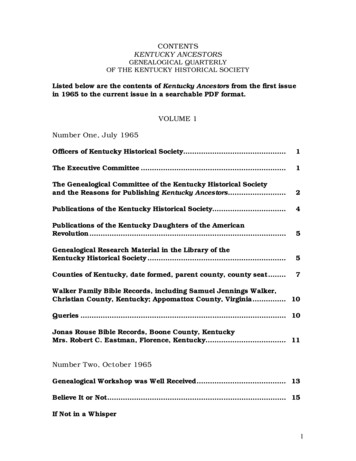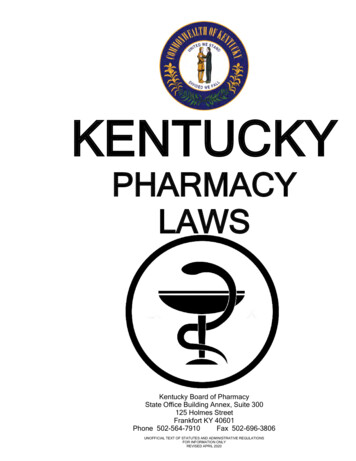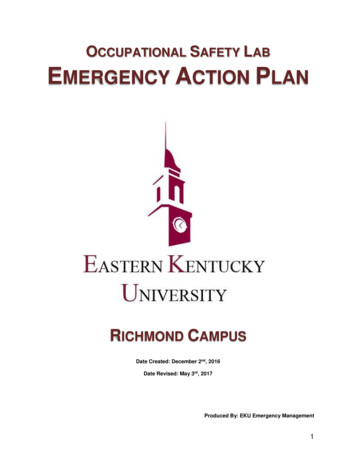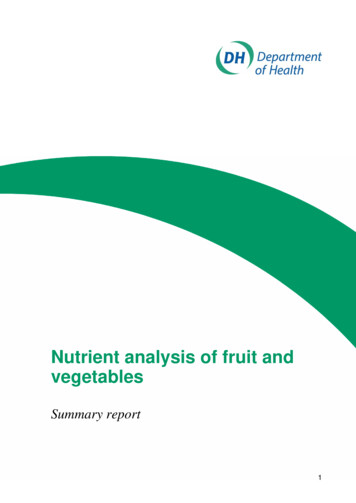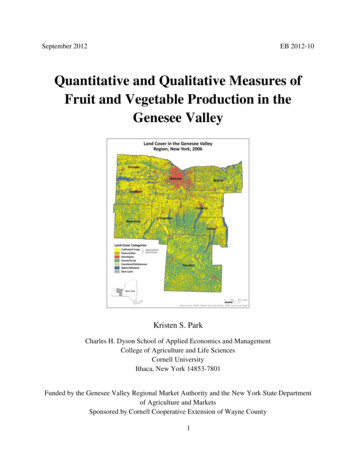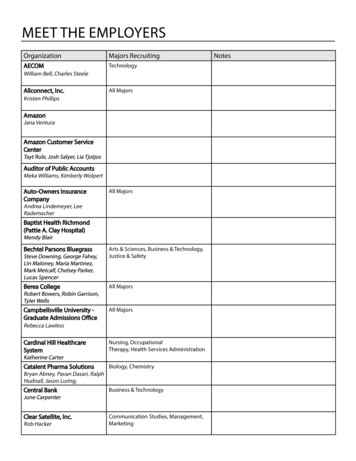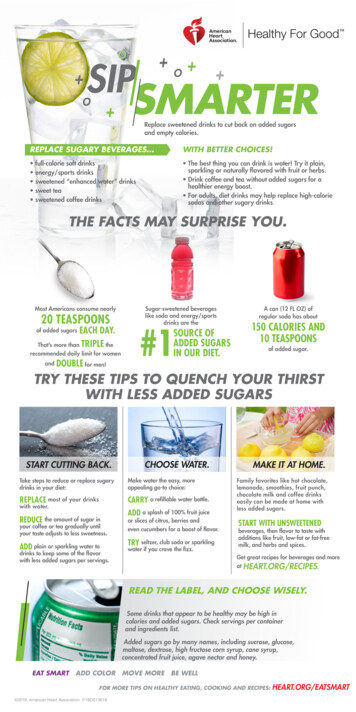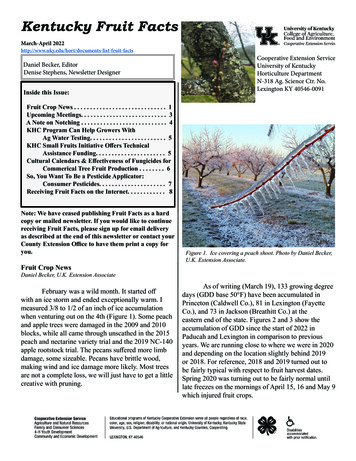
Transcription
Kentucky Fruit FactsMarch-April actsDaniel Becker, EditorDenise Stephens, Newsletter DesignerInside this Issue:Cooperative Extension ServiceUniversity of KentuckyHorticulture DepartmentN-318 Ag. Science Ctr. No.Lexington KY 40546-0091Fruit Crop News . . . . . . . . . . . . . . . . . . . . . . . . . . . . . 1Upcoming Meetings. . . . . . . . . . . . . . . . . . . . . . . . . . . 3A Note on Notching . . . . . . . . . . . . . . . . . . . . . . . . . . . 4KHC Program Can Help Growers WithAg Water Testing. . . . . . . . . . . . . . . . . . . . . . . . 5KHC Small Fruits Initiative Offers TechnicalAssistance Funding. . . . . . . . . . . . . . . . . . . . . . 5Cultural Calendars & Effectiveness of Fungicides forCommerical Tree Fruit Production . . . . . . . . 6So, You Want To Be a Pesticide Applicator:Consumer Pesticides. . . . . . . . . . . . . . . . . . . . . 7Receiving Fruit Facts on the Internet. . . . . . . . . . . . 8Note: We have ceased publishing Fruit Facts as a hardcopy or mailed newsletter. If you would like to continuereceiving Fruit Facts, please sign up for email deliveryas described at the end of this newsletter or contact yourCounty Extension Office to have them print a copy foryou.Fruit Crop NewsFigure 1. Ice covering a peach shoot. Photo by Daniel Becker,U.K. Extension Associate.Daniel Becker, U.K. Extension AssociateFebruary was a wild month. It started offwith an ice storm and ended exceptionally warm. Imeasured 3/8 to 1/2 of an inch of ice accumulationwhen venturing out on the 4th (Figure 1). Some peachand apple trees were damaged in the 2009 and 2010blocks, while all came through unscathed in the 2015peach and nectarine variety trial and the 2019 NC-140apple rootstock trial. The pecans suffered more limbdamage, some sizeable. Pecans have brittle wood,making wind and ice damage more likely. Most treesare not a complete loss, we will just have to get a littlecreative with pruning.As of writing (March 19), 133 growing degreedays (GDD base 50 F) have been accumulated inPrinceton (Caldwell Co.), 81 in Lexington (FayetteCo.), and 73 in Jackson (Breathitt Co.) at theeastern end of the state. Figures 2 and 3 show theaccumulation of GDD since the start of 2022 inPaducah and Lexington in comparison to previousyears. We are running close to where we were in 2020and depending on the location slightly behind 2019or 2018. For reference, 2018 and 2019 turned out tobe fairly typical with respect to fruit harvest dates.Spring 2020 was turning out to be fairly normal untillate freezes on the mornings of April 15, 16 and May 9which injured fruit crops.
Figure 2. Paducah growing degree day accumulation (base 50 F) for 2021 and past years. MattDixon, U.K. Ag Meteorologist.Figure 3. Lexingtongrowing degree dayaccumulation (base50 F) for 2021 and pastyears. Matt Dixon, U.K.Ag Metorologist.What is a normal season and how does itcompare historical averages? Matt Dixon, U.K. AgMeteorologist, wrote an excellent article in last year’sMarch edition of Fruit Facts on this topic, les/documents/FFMar21.pdf. I have reread it periodicallywhen difficult weather events occur for perspective.Looking ahead, the NOAA’s ClimatePrediction Center is forecasting that near-normalseasonal temperatures will give way to warmerand wetter than average conditions for the rest ofMarch. The above average temperature trend willhold going into April. The models do not account forperiodic cold weather events that bring with them thepossibility of crop damage.Shawn Wright, extension specialist, basedover at the Robinson Center in Jackson reports thatthe earliest blueberries are at bud swell and that henoticed first bloom on ‘Saturn’ peach on March 6. Themasthead shows a ‘YumYum’ nectarine bud at pinkstage. One of his plasticulture strawberry growersalready had bloom on ‘Ruby June’. With the upcomingreturn to more normal temperatures, any strawberrygrowers with advanced bud development will have towork hard to repeatedly pull covers over plants. Somemay even need to double cover several times to protectblooms. The critical temperature for closed buds is 2227 F and is 30 F for open flowers of strawberries anda 1-1.25 oz./sq. yd. can only be relied on to provide upto 4-5 F of protection.2
Program:All times EST10:00 a.m.Registration & Tour of Appledale Farm& Market - Don, Mike, Mark, andDavid Haney11:00Pests and Insecticide Programs Ric Bessin11:30Peach Thinning and Split Pits John StrangNoonLunch will be available at cost forthose that preregister.We are not as far along over at the UKRECin Princeton. Apples are at silver tip and ‘Redhaven’peaches will have the earliest blooms open the weekof March 20-27. The few sweet cherries that we haveare also showing green tip. A bud mortality sample onMarch 16 from two shoots under 12” and two shootsover 24” collected each from five ‘Redhaven’ treeson Lovell rootstock had a 35% survival rate. This is asurprisingly low overall survival rate but still enoughfor a potential full crop.On a sad note, the Department of Horticulturewill be losing Chris Smigell at the beginning ofMay. Chris has decided to retire after many years asthe Extension Associate for fruit crops. Many fruitgrowers in central and northern Kentucky know Chrisfrom site visits and speaking at the Annual F&VConference and Fruit Grower Orchard Meetings. Hisexpertise and opinions will be missed.Please preregister as we are veryunsure about our lunch estimate dueto the COVID situation.Preregister for lunch by emailing orcalling John Strang, jstrang@uky.edu,859-396-9311 by Friday, May 13 andprovide a count for the Fruit GrowerMeeting at Haney’s OrchardUpcoming Meetings12:45p.m.Tree Wounds and Opportunistic Fungi Nicole Ward Gauthier1:15Signage - Brett Wolff1:40Grower Round Table Discussion -Jonathan Price, moderatorAll times EDT unless noted.May 17, Fruit Grower Orchard Meeting.Haney’s Appledale FarmDon, Mike, Mark, and David HaneyHaney’s Appledale Farm8350 Hwy. 80Nancy, KY 42544Phone: 606-636-6148 (Market)Website: https://haneysappledalefarm.com/Mar. 30. Calibrating Backyard Sprayers.Darrell Simpson, UK ANR Agent for MuhlenburgCounty, presenter. This is part of the HorticultureWebinar Wednesday’s series. A registration link andlinks to past presentations from seasons one throughthree are available at https://kentuckyhortnews.com/.Apr. 5. Apple Grafting Workshop.Henderson County Extension Office, 3342 KY-351,Henderson, KY 42420. Schedule TBD. ContactAndrew Rideout, Henderson County Extension Agentfor Horticulture for details: pandrewrideout@uky.eduor (270) 826-8387.Jan. 3-4, 2023. Kentucky Fruit andVegetable Conference. Schedule TBD. SloanConvention Center, 1021 Wilkinson Trace, BowlingGreen, KY 42103. Contact Kentucky HorticultureCouncil, (859) 490-0889, info@kyhortcouncil.org.This will be an IN-PERSON meeting.Directions:From Highway 27 – In Somerset, take light number4 west onto Kentucky Highway 80 and drive eightmiles. Haney’s is on the right.From Interstate 75 – Take exit number 62 (KY-461/Renfro Valley/Mt. Vernon). From exit, take Highway461 to Highway 80. Follow to 80-27 Intersection.Take Highway 80 West to Nancy (8 miles)From the West – Take the Louie B. Nunn Parkway(Cumberland Parkway) to exit 78 and proceed southon old 80. Haney’s Appledale Farm will be on the lefton the far side of Nancy, KY.3
A Note on NotchingBy Dwight Wolfe, Research SpecialistNotching (scoring the bark just above a bud) is one of a number of tools that can be used to initiatebranch development along the tree trunk in areas lacking suitable branching. In the spring of 2020, a mixture ofwhite latex paint and 7500 pm of 6-Bensyladenine as MaxCel Plant Growth Regulator (Valent U.S.A. LLCAgricultural Products) was applied to wounds from notching various buds along the trunk about 4 to 6 feet fromground level of trees in our 2019 NC-140 Regional Apple Rootstock Trial (Figure 1). The trial was plantedin the UKREC orchard on April 11, 2019, on a 3 x 13.5-ft. spacing using feathered trees from Gold CrownNursery, Quincy, WA. Kentucky was allocated seven of the 13 rootstocks in this trial: One Budagovsky stock(B.10), two Malling stocks (M.9 NAKBT337) M.26 EMLA), three Geneva stocks (G.41, G.814, and G.969),and one New Zealand stock (NZ.2). Yield and growth measurements are reported annually in Kentucky’s fruitand vegetable annual research report pdf , but resultsfrom notching these trees last spring is shown in Table 1 below.Table 1. Results from notching trees in the 2019 NC-140 ‘Buckeye Gala’ rootstock trial.Rootstock1Truck CrossNumber ofPercent ofAverage% of notches-Sectionaltress notched3 / the treesnumber ofresulting inArea (sq. in.) number in trial needing some notches/trees a new 9G.814Averageshoot length(cm)1.381.3915/1514/15100 a93 ab3.203.4352.1 b50.7 4/15100 a100 a100 a73 b93 ab3.333.473.332.373.2056.6 b77.9 ab78.8 ab76.5 ab96.6 a23.537.432.326.833.8Mean1.6794.23.0469.033.8LSD2 (5%)25.60.92 (ns)31.834.0 (ns)1 Arranged in ascending order of trunk cross-sectional area for each rootstock.2 Tukey’s significant difference P 5%. Differences between two means within a column that are less than theTukey’s significant difference value are not significantly different.3 Trees that had sufficient branching were not notched.One tree on M.9, one tree on G.814, and four trees on G.969 were not notched because these trees didnot need more branching in the area where we were notching these trees. G.814, M.26, and G.969, produce treesabout 40, 45, and 65 percent of standard size trees, respectively. The other four rootstocks produce trees that are35 percent of standard size.There were no significant differences in the average number of notches per tree for those trees thatwere notched nor were there any significant differences in average length of new shoots from the notched budsamong the seven rootstocks. But the percent of the notches resulting in new shoots did vary by rootstock andappears to be somewhat correlated with trunk cross-sectional area or tree vigor, with Pearson’s correlationcoefficient being equal to only 0.61419. This is not a very high value and would indicate that only about 38% of4
launched this program in 2019 through a partnershipwith National Farmers Union’s Local Food SafetyCollaborative (LFSC). The water requirements forFSMA (the Food Safety Modernization Act) will bein effect starting in 2022 for the largest tier of producegrowers and growers should begin sampling nowto develop their microbial water quality profiles orMWQPs.“As part of our program, we will come tothe farm, take the samples, and deliver those to thelaboratory for analysis,” says Cindy Finneseth, KHCexecutive director. “We will also help you manage thetest results – organizing the data and calculating thestatistical thresholds. If there is a high risk associatedwith the water source, we can talk through optionsand help you determine the best management strategyfor your operation.” KHC has space for a few moregrowers interested in participating in the 2021/2022program.Growers who participate in the programreceive one-on-one sampling training, sample analysis,and individualized interpretation of test results. Moreinformation about the program can be found onKHC’s website: -pilot/. If you would like to participatein the program or would like additional information,please send an email to Dani D’Antonio at Dani@kyhortcouncil.org or to info@kyhortcouncil.org.the variation in shoot development is explained by treevigor.The active ingredient in MaxCel is acytokinin, a class of plant hormones that promote celldivision. Along with auxin, another plant hormone, thecytokinin to auxin ratio appears to regulate bud growthand apical dominance by promoting secondary budgrowth or branching when this ratio is relatively high.But exactly how these hormones interact to affecttree vigor and branching is not understood, let aloneany interaction they may or may not have with therootstock. More work is needed to understand theseprocesses.KHC Small Fruits Initiative Offers TechnicalAssistance, FundingFrom the Kentucky Horticulture CouncilThe Kentucky Horticulture Council (KHC)began recruiting existing and prospective small fruitcrop growers on October 1st for its Small FruitsInitiative. The KHC is partnering with the Universityof Kentucky to sponsor the initiative, which willprovide educational opportunities and resources tocurrent and prospective small fruit crop growersacross rural Kentucky. As part of the program growerswill receive access to: On-farm technical assistanceincluding: Production planning (open field and/orhigh tunnel) Harvest advice Post-harvest handling recommendations Marketing advice A specialized funding pool to financeestablishing or expanding plantingsFigure 4. The painted notched bud in the foreground (1) didnot break, but the painted notched bud on the opposite sideof the trunk (2) did break and formed a shoot.KHC Program Can Help Growers With AgWater TestingFrom the Kentucky Horticulture CouncilThe Kentucky Horticulture Council (KHC)is working with local growers using ponds, wellsand other nonmunicipal water sources to irrigateproduce crops. The KHC ag water testing programhelps produce growers better understand the microbialquality of their surface and ground water sourcesused for production and post-harvest activities. KHC5
Complete and submit a grower profile online (https://www.surveymonkey.com/r/SmallFruits2020) ordownload /10/Grower-Profile.pdf) to email or mailto KHC for review.Small fruit crops with primary commercialpotential in Kentucky are blackberries, blueberries,and strawberries. Other small fruit crops that mayhave commercial potential in Kentucky includeelderberries, table grapes, gooseberries, and Junebearing raspberries (red and black). Crops notlisted here should be discussed with your technicalassistance provider.Program requirements are simply that the grower: Farms in a designated rural area, and Is interested in growing and sellingsmall fruit cropsFigure 5.These cultural calendars are availablefor apple and peach production.These publications, which focus oncommercial tree fruit production, providerecommended cultural practices at the variousgrowth stages/production periods. Each serves as asupplement to published spray guides and scoutingguides. The cultural calendars are available online:—Cultural Calendar for Commercial AppleProduction iles/ppfs-fr-t-25.pdf—Cultural Calendar for Commercial Peach Production(PPFS-FR-T-26): 26.pdf .Inputs like plants, fertilizer, mulch, andpesticides are qualified expenses in this program aswell as services like terracing, bed raising/shaping andharvest labor. Some items for post-harvest handlingand to ensure food safety may also be allowed.Growers are approved for up to 1,250. For additionalinformation about this program, go to itiative/.Efficacy tables for fungicides used to managefruit diseases are available for stone fruit and apple.These guides provide decision-making tools to helpgrowers select effective fungicides from differentchemical classes (FRAC groups). The efficacy guidesare accessible online:—Effectiveness of Fungicides for Management ofStone Fruit Diseases iles/ppfs-fr-t-14.pdf—Effectiveness of Fungicides for Management ofApple Diseases iles/ppfs-fr-t-15.pdfCultural Calendars & Effectiveness of Fungicidesfor Commercial Tree Fruit ProductionBy Cheryl Kaiser, Plant Pathology Extension Support,and Nicole Gauthier, Plant Pathology ExtensionSpecialistIntegrated pest management (IPM) includesthe combination of biological, cultural, physical,and chemical tools in efforts to manage diseasesand pests while minimizing risks associated withpesticides. Cultural practices are an integral part ofan IPM program and should be incorporated intoall commercial systems, whether large or small,conventional or organic.For additional publications on fruitdiseases, including fungicide efficacy tables forcommercial grape and strawberry, visit the UK PlantPathology Extension Publications webpage, tions.6
So, You Want to be a Pesticide Applicator:Consumer PesticidesBy Ric Bessin, Extension EntomologistInherently, pesticides have some risks to theenvironment, the plants or animals being protected,consumers, and/or the applicator. Those pesticideswith higher risks have been designated RestrictedUse Pesticides (RUP), which require training andcertification for their users, while pesticides withless risk are General Use Pesticides and are availablewithout specialized training and certification.Restricted Use Pesticides are clearly marked with awarning box on the front label.This article discusses some of the safetymeasures for general use pesticides, those used bypersons without training or certification.Figure 8. Use any personal protective equipment listed inthe Precautionary Statements section of the pesticide label.(Photo: Ric Bessin)Protective ClothingMany consumer pesticide labels clearly specifywhat types of protective clothing is required duringapplication; some do not have requirements. For thosethat don’t specify what types of protection is required,I suggest the user wears at least long pants, longsleeved shirt, shoes plus socks, and plastic or rubbergloves.Concentrates vs. Ready to UseWith consumer pesticides, some requiredilution with water and may be designated asFigure 6. Even general use consumer pesticides carry someconcentrates; others are Ready-to-Use (RTU) orrisk and must be used according to the label directions.TheLabelis the UK)LawReady-to-Spray (RTS) formulations. RTU and RTS(Photo:Ric Bessin,Even though no special training is neededpesticides do not require dilution and are often appliedfor persons over 18 to purchase and use General Useto surfaces until thoroughly wet.Pesticides, users still must follow all label instructions.Concentrates, on the other hand, are dilutedThe label is the law!with water, and applications must be calibrated todeliver a fixed amount per unit area. Rates are oftenexpressed as a fixed amount per 1000 square feet.Users will need to calculate the area intended to betreated to determine the amount of product needed.Other Label InformationThe type of area to be treated (e.g. lawn,fruit, foundation, etc.) must be listed on the label.All pesticides restrict adults, children, or pets fromentering the treated area until sprays have dried.Pesticides applied to edible plants list a required‘days until harvest’ waiting period for each type ofedible plant to ensure pesticides residues degrade toFigure 7. The first sentence of the ‘Directions for Use’negligible levels through exposure to wind, rain, andsection of nearly all pesticides labels notifies users that theysunlight.are required to follow all label directions.7
A statement on all pesticide labels includes“Keep out of reach of children.” Generally, peoplepurchasing and using pesticides should be at least 18years old.StorageWhen pesticides are not being used, theyshould be stored in a locked cabinet or room thatis kept cool and dry and according to ‘Storage andDisposal’ requirements on the pesticide label. It isimportant to keep pesticides inaccessible to childrenand pets at all times.Pesticide ExposureWhen using pesticides, if some of the productgets on your skin, thoroughly wash it off with soap andwater. If it gets in your eyes, flush your eyes for 15minutes with clean water and check the label for moreinstructions. If swallowed, check the label for firstaid instructions as these vary according to the type ofpesticide ingested, and then seek medical attention.After using pesticides, wash thoroughly before eating,drinking, using tobacco, or using the toilet. Clothingused while applying pesticides should be washedseparately from that of the rest of the family laundry,and the washer should be run once on rinse after theclothes are removed. Heavily contaminated clothesshould be discarded.Each pesticide label will have a sectionto address first aid for emergencies. There willbe a phone number for the National PesticideInformation Center along with specific emergencymedical treatment information. The doctors and firstresponders will need to know the name of the product;you should have the product container or label whencalling a poison control center or speaking with adoctor.The Answers are on the LabelWhen you have questions about using apesticide, reading the label is the first place to look forthe answer.Fruit & Vegetable HumorleAppnaCall mpet?uoDo Y the TrutaWh PlaystTha!!TY!IUY FRTOOAT9
Receiving Fruit Facts on the InternetBy subscribing to the email notification service youwill receive an email announcement when each newissue is posted on the web with a link.To subscribe, send an email it Factssubscribe KY-FRUITFACTSFollowed by a blank lineOR to unsubscribe, the lines:signoff KY-FRUITFACTSFollowed by a blank line You shouldreceive confirmation by return email. If you have aproblem, or if you wish to communicate with a personabout “fruitfacts”, the owner’s address (the TO: line ofthe message) is: owner-ky-fruit-facts@lsv.uky.edu
4 west onto Kentucky Highway 80 and drive eight miles. Haney's is on the right. From Interstate 75 - Take exit number 62 (KY-461/ Renfro Valley/Mt. Vernon). From exit, take Highway 461 to Highway 80. Follow to 80-27 Intersection. Take Highway 80 West to Nancy (8 miles) From the West - Take the Louie B. Nunn Parkway
